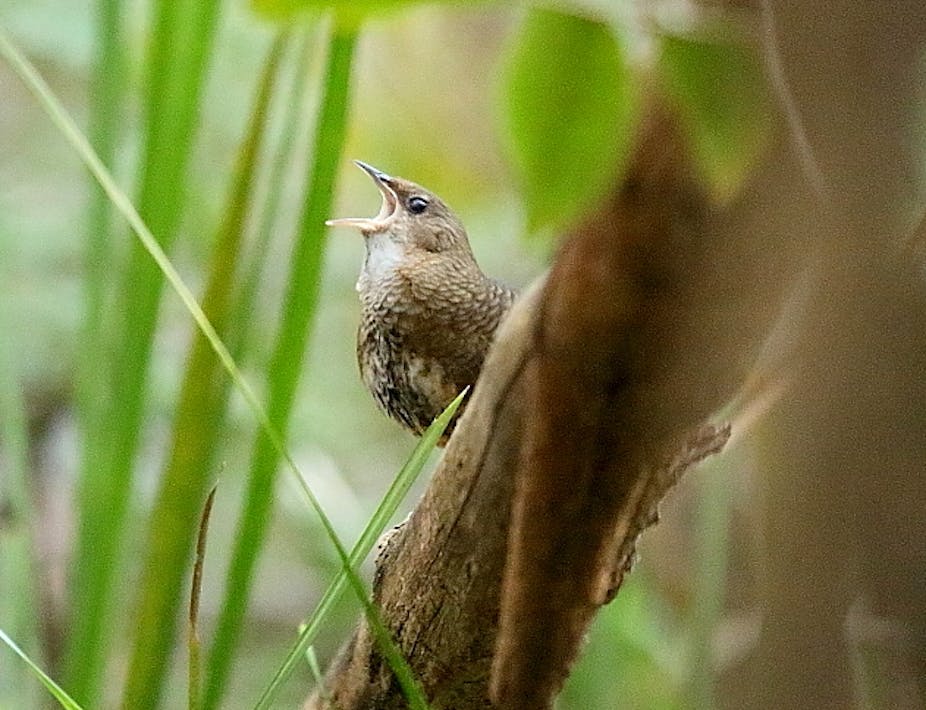Rufous Scrub-birds have been calling loudly from the mountains of eastern Australia ever since Australia parted from Gondwana 65 million years ago. They are still there today – as noisy as ever, though incredibly difficult to see – but perhaps not for much longer.
Models predict that the climate of places like the Lamington Plateau in southeast Queensland will change to something quite unlike what is there at the moment. That is one of the scenarios described in the Climate Change Adaptation Plan for Australian Birds.
More than 100 Australian bird species face the prospect, within half a century, of having nowhere in the country with a climate quite like the one they now enjoy. It begs the question of what we should do, should these model predictions be confirmed.
Limited options
There is a fairly limited range of actions we can take, and climate change is challenging some fundamental beliefs about the very purpose of conservation. No longer can protected areas be expected to safeguard all of the species that currently live within them.
One option is to do nothing: to accept human-induced changes to the planet as natural, and let evolution take its course. After all, previous mass extinctions have been followed by a prolific emergence of new species. But that wouldn’t occur in our lifetime, and perhaps not even within the lifetime of humans as a species.
An alternative to this long-term perspective is to help climate-challenged species to survive where they are, especially in places that have proved to be refuges in the past, such as pockets of the Wet Tropics or the northwest Kimberley.
Relieving species of pressure from predators and competitors by protecting their nests and providing extra food may lift survival rates enough to compensate for extra climate-related deaths. Such intensive management is already applied to some threatened species – so perhaps we should just extend it to the climate-challenged. Such interventions may become increasingly expensive, but at least they will keep species in their “natural” environment.
A moving problem
Another option is assisted colonisation. For Rufous Scrub-birds, the climate in Tasmania should become suitable even as that in New South Wales and Queensland becomes unsuitable. A relative of the scrub-bird, the Superb Lyrebird, has been introduced successfully to Tasmania, so we might expect scrub-birds to have at least a reasonable chance of survival.
There are now many examples from around Australia of animals being moved to places, particularly islands, where they have not been recorded before so that a population can be secured.
For some birds it is not whole species that need be moved, just some of their genes. In our Action Plan, many of the birds that are predicted to lose their climate space could be replaced by close relatives that live in a slightly different climate. For instance, the population of Tasmanian Brown Thornbills could be augmented by bringing in members of the mainland subspecies that is adapted to warmer climates. The purity of both subspecies would be compromised, but that is surely better than having them go extinct.
Then there are zoos. The investment would need to be substantial, and keeping enough genetic diversity is a challenge, as evolutionary processes in captive populations can end up with animals quite different to their wild counterparts.
However, captive insurance populations are key to the conservation of Helmeted Honeyeaters and Orange-bellied Parrots. We have no idea whether zoo populations can persist in perpetuity, or at least until the climate improves (effectively the same thing), but it can be done. Père David’s Deer has been extinct in the wild for 2,000 years, while still surviving in captivity.
Eventually, the option of last resort for threatened birds may be cryogenics, or even a virtual life as preserved genetic code. Currently, such options are science fiction, and somehow I suspect that society will put less value on a frozen egg or a string of nucleic acid codes than a real-life squawking, feathered animal, even one in a zoo.
Tough decisions
All of the options above are feasible, if expensive, and at some stage the government will to have to make some hard decisions about where to invest in climate change adaptation. However, politicians have had little guidance on what options the public might prefer.
While there has been heated debate on the merits of assisted colonisation (see also here), and some researchers have assumed captive populations have little conservation value, these are personal opinions on what are fundamentally moral issues. In democracies, government investment is ultimately decided through the ballot box, so a key recommendation for the adaptation plan has been surveys on the social acceptability of different adaptation options.
This social consultation is one of our reasons that we have written this article. What do you think might be the best option for the Rufous Scrub-bird? Leave it adapt, help it stay where it is, move it to Tasmania, or establish a population in a zoo? What about Brown Thornbills? Where would you like the government to invest in saving species from climate change? What might you personally be willing to invest? If funds are limited, which options or birds would you abandon?
If you have an opinion about how to respond, should climate change start affecting wild bird species in Australia, we would welcome hearing it. Anyone can take this short, anonymous, online survey – and what you say can help us, policy makers and managers develop appropriate climate change adaptation strategies for wild birds.

